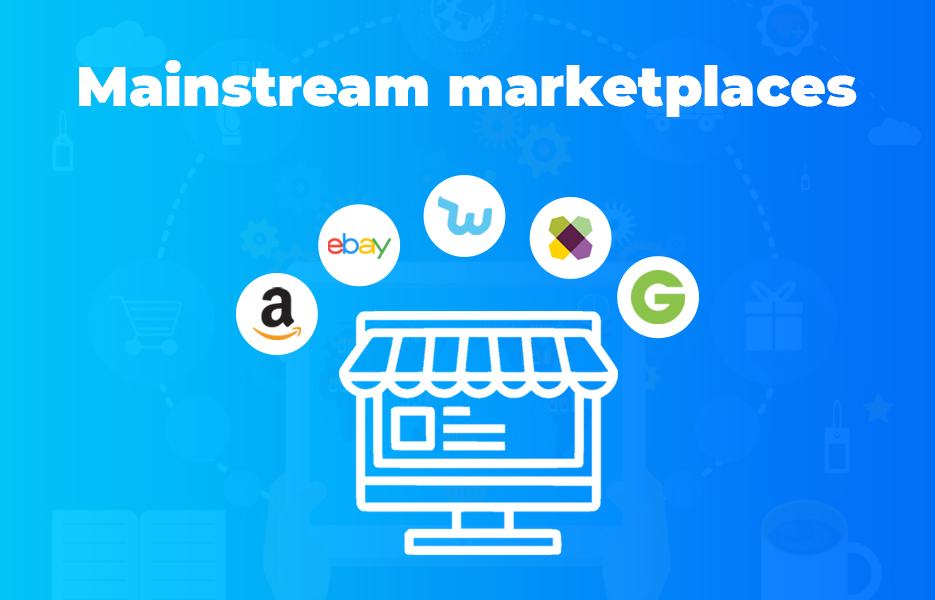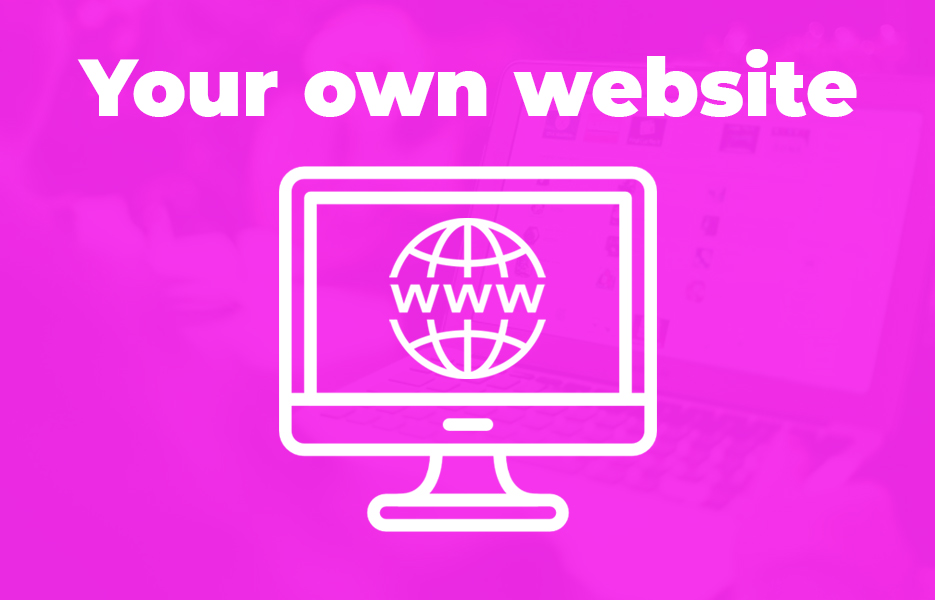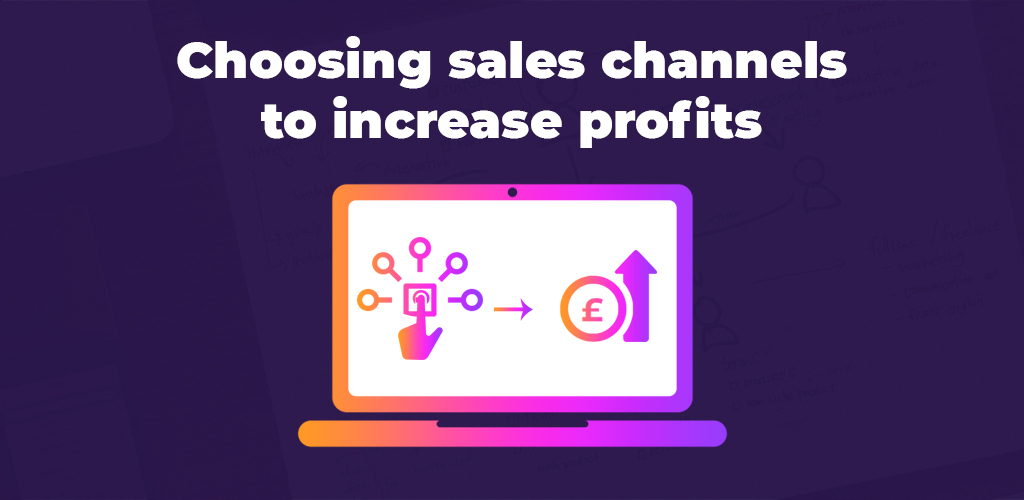Choosing sales channels to increase profits
Following on from our post about adding sales channels to your Avasam account, today we’re taking a look at choosing your sales channels. If you want to make more profits (and we’re sure you do!) one way you can do this is by increasing the number of sales channels you have.
The challenge

When they are getting started, many sellers that are new to eCommerce and DropShipping assume that the sales channels they’re going to be most successful on are the big ones. It makes sense, since we’ve all heard of Amazon and eBay, it stands to reason that they will be the most likely places that you’ll get sales – right? Well, maybe not.
If you’re listing your items amongst retailers that can lower their margins because they can buy in bulk and therefore set their prices lower, it can be really hard to compete. Potential customers are able to see those lower prices right there next to yours. If your competitors have products that are exactly the same as yours, you’ll find it hard to win those sales – you wouldn’t pay more for the exact same product, so why would your customers?
What can you do about this then, without cutting your profit margins to next to nothing, or even risking a loss? One of the ways that you can keep growing your sales without risking your profit margins is to avoid the competition – if not completely, then you can at least avoid some of them by selling elsewhere. The good news is that while Amazon and eBay might be the biggest eCommerce marketplaces, they’re not the only options you have available to you, especially as an Avasam seller. Selling on different marketplaces, and your own website can be the key to unlocking greater profits.
The main thing to remember is that every business is different, so listing on each of these marketplaces won’t necessarily be the right move for every business, but let’s take a look at some of the other sales channels that Avasam has integrations for, as well as the pros and the cons of each.
Mainstream marketplaces

These are the ones we consider the most popular with customers in the UK – the likes of Amazon and eBay fall into this category.
There are four major benefits to listing your products on marketplaces:
Customers already trust the marketplace. Customers have probably (especially in the case of Amazon and eBay) bought from the marketplace, so they know they are covered if something goes wrong with their order.
They can reduce your marketing costs. This is especially the case where the marketplace uses algorithms to show the customer items that they are likely to buy, like Wish. Your products will quite literally be placed in front of the customers that are most likely to buy the item – which is almost impossible to do yourself without a massive budget and stacks of time.
You can hop in and out as you like. If you’ve built a website and it isn’t performing for you, you kind of have to keep going and work SEO until you start to see sales. With marketplaces though, unless you have paid a monthly fee to list on there, you can stop listing whenever you like – so if you’re not seeing returns, you can simply stop.
Some marketplaces are great for testing. If you’ve identified a product that could be the next big seller, but you’re not 100% sure, then listing the item on a marketplace where you only pay commission on each sale is a risk-free way to test your product(s).
Amazon
We probably don’t need to tell you anything about Amazon – we doubt anyone can read absolutely anything about eCommerce and not encounter a mention! While selling on Amazon UK might not be the right move for your business if there is too much competition in your niche, Amazon is expanding their reach further than ever. There are currently 16 Amazon marketplaces worldwide:
- United States
- Canada
- Mexico
- United Kingdom
- Germany
- France
- Italy
- Spain
- Japan
- Singapore
- United Arab Emirates
- Brazil
- Australia
- India
- Netherlands
- Saudi Arabia
- Turkey (limited categories)
With this many marketplaces, where Amazon UK isn’t going to provide you with the sort of profits you’re looking for, be sure to investigate where there might be opportunities on one of their other worldwide platforms. You can have multiple Amazon accounts connected to your Avasam account, so you won’t need to worry about keeping product levels synced – the platform takes care of that for you.
| Advantages of selling on Amazon: | Challenges of selling on Amazon: |
|---|---|
| Massive brand awareness worldwide FBA can increase the chances of your listing being selected Marketing costs may be smaller | Getting started can be tricky Amazon frequently suspend seller accounts Payments to you can be slow Huge competition Product restrictions Gaining feedback can be difficult. No feedback means customers are less likely to buy from you |
eBay
Like Amazon, eBay is well-known internationally, which presents sellers with a number of options. They have 23 marketplaces, and have customers in more than 100 countries worldwide, so be sure to check if another eBay territory might work for you.
| Advantages of DropShipping on eBay | Challenges of DropShipping on eBay |
|---|---|
| Very easy to start Massive reach Potential decrease in marketing budget Selling worldwide is easy | Upfront listing fees Customisation options are limited |
Wish
Wish has been around just 10 years, which is a baby compared to Amazon and eBay! The mobile app is one of the most popular amongst customers worldwide, and by listing your products on there, you’re exposing your products to millions of customers. Not only that, the big winner with Wish? They place your items right in front of the customers that would be interested in them.
| Advantages of DropShipping on Wish | Challenges of DropShipping on Wish |
|---|---|
| Reach international customers quickly and easily No upfront fees – pay commission on your sales Mobile app is incredibly popular Listings are targeted in accordance with customer interests | Low prices Not all customers trust Wish Collecting reviews can be difficult |
Groupon
Like Wish, Groupon use the power of their algorithm to target products to customers. This means that – done carefully – Groupon can be a useful addition to your strategy. There can be difficulties with Groupon though, so be sure you do your research carefully before you get started.
| Advantages of DropShipping on Groupon | Challenges of DropShipping on Groupon |
|---|---|
| Targeted listings Wide brand awareness and customer trust Popular mobile app helps to drive sales | Customers come to Groupon for rock-bottom prices No chance to build brand awareness Managing Groupon sales can be tricky |
Wayfair
Wayfair started life as a DropShipping business, so they know exactly what the challenges are that you face. The focus of Wayfair is homewares, and the great thing (or the challenge, however you want to look at it) is that customers usually have something specific in mind when they come to Wayfair.
| Advantages of DropShipping on Wayfair | Challenges of DropShipping on Wayfair |
|---|---|
| Customers know what they want Wayfair is trusted and has great brand awareness The platform launched as a DropShipping marketplace | Delivery options can be tricky Customers demand unique products |
Local marketplaces
When you’re thinking about sales channels, don’t stop with domestic marketplaces! Think big – selling on marketplaces that are local to other countries might be smaller, but can help to increase the number of customers that you can sell to. Depending on what you’re selling, it is likely that you will encounter less competition for some items, meaning that if you find there is demand for them in that territory, you can become the preferred seller.
Trade Me – customers in New Zealand. Classified and auction listings – find information about fees here.
Fyndiq – customers in Sweden looking for bargains. No fees unless your items sell. Find out more here.
Coolshop – customers across northern Europe and Scandinavia. Low rates of commission.
Spartoo – sells mid-range and luxury fashion to more than 25 countries.
Charges a monthly fee and commission on the final sales price.
Linio – sell in Latin America, commission on each sale. Get 1% off standard commission on this page.
Ozon – sell to millions of customers across Russia.
Bol.com – sell across Belgium, The Netherlands and Luxembourg – just commission on your sales.
Privalia – customers in Spain and Italy. No fees, just commission between 5% and 20%
Mercado Libre – customers across Latin America. Commission charged, no other fees.
Flipkart – sell to customers in India, with a simple commission structure.
Elala – sell customers in India, with a small commission that is agreed when you register.
Yatego – sell to customers in Germany – commission rates are variable.
When you’re looking at international marketplaces, you need to be careful to factor shipping into your costs – you don’t want to accidentally wipe out your profit margins because you forgot to add those into your calculations.
Your own website

You can make plenty of sales on marketplaces – and they are probably going to be a major part of your seller strategy, but they aren’t your only option. In fact, it’s wise to not rely on your marketplaces entirely, for a number of reasons:
- Seller accounts can be suspended, meaning you have to fight to get your account reinstated – all the while you’re not making any sales
- Cashflow can be slow, since some marketplaces hang onto your payments – meaning you need to use a credit card or build up a cash buffer
Having your own website allows you a lot more control over your sales, and you won’t have to pay commission or monthly fees on your sales – you’ll just need to pay your website hosting fees, which will be a set amount and will be significantly less than website fees and commission! Not only that, when your customers make their purchase through your website, you’ll be able to access that cash immediately – unlike those marketplaces that hang onto your payments for days or weeks.
Having your own website can be pretty simple, but there are a few things you’ll need to work on. Depending on how you decide to build your website, it might be pretty simple to put together – especially if you’re using a website builder such as Shopify or BigCommerce.
Your website costs can be pretty low – especially if you use an open source solution and you choose your domain name and hosting carefully.
Paid website solutions
- Shopify
- BigCommerce
- nopCommerce
- 3dcart
- Zencommerce
- Kartrocket
Open source solutions
- WooCommerce
- Magento
- PrestaShop
- OpenCart
- osCommerce
- Zen Cart
- X-Cart
Once you’ve created your website, you’ll need to keep your website updated and secure (that should go without saying, but it is so important that we always make sure we include it!) and you’ll need to work on getting customers to your website. Make use of plugins to help you manage SEO, and consider how content marketing strategy can help you to increase traffic to your website as well as increase trust.
Choosing your strategy

There are many different ways you can create your strategy, and the sales channels that you choose will very much depend on the products you’re selling and what you want your business to achieve. You’ll need to conduct your own research, taking into account costs for selling on different marketplaces, demand for your products, your target customer.
The more sales channels you add to your Avasam setup, the more opportunities for sales you have – but the key is to choose them carefully. Remember, the beauty of DropShipping businesses is that they are pretty dynamic, and what is right for your business this month might not be the right thing in six months, or next year. You’ll have discovered how simple it is to add and remove sales channels on Avasam – or even just to pause them – so you’re not tied to anything as far as Avasam is concerned. Sell in the UK today, Russia next week and New Zealand next year – or take a completely different approach, it is up to you.
We’ve taken only a quick look at each of these sales channels in this post, but we hope this has inspired you to continue to grow your business! The key things to remember:
- Do your research before you get started – the obvious choice may not be the right choice
- Choose a range of sales channels that make sense for your business
- Use marketplaces with no fees to test new products
- Look at international marketplaces to really increase your profits
- Keep working on marketing your products and growing your business
If you’ve yet to get started, or you have questions get in touch! Our team have years of experience in eCommerce, and we can advise you about your strategy.
This post contains affiliate links. If you use these links to buy something, we may earn a commission. We only use referral links for businesses that we would use ourselves. Thanks for your support!



DropShip products from verified suppliers to diversify your inventory and scale your eCommerce business